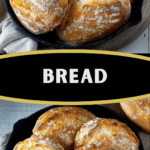Why You’ll Love This Recipe
Homemade bread is incredibly satisfying to make, and the results are always worth it. This recipe creates a soft, fluffy loaf with a golden, slightly crispy crust, perfect for toasting, spreading with jam, or dipping in olive oil. The best part is that you can control the ingredients and skip the preservatives often found in store-bought bread. The process is simple, and while it takes some time for the dough to rise, there’s nothing more rewarding than watching your bread bake and enjoying a warm slice straight out of the oven.
This bread is versatile enough to be enjoyed as an everyday staple or dressed up for special occasions. Whether you use it for sandwiches, alongside soups, or simply with butter, it’s a comforting addition to any meal.
Ingredients
-
3 cups all-purpose flour
-
1 tablespoon sugar
-
1 packet (2 1/4 teaspoons) active dry yeast
-
1 1/2 teaspoons salt
-
1 tablespoon olive oil (or vegetable oil)
-
1 1/4 cups warm water (about 110°F)
-
1 tablespoon butter (optional, for brushing on top)
(Tip: You’ll find the full list of ingredients and measurements in the recipe card below.)
Directions
-
Activate the Yeast: In a small bowl, combine the warm water, sugar, and yeast. Stir gently and let sit for about 5 minutes, or until the mixture becomes frothy. If the mixture doesn’t foam, your yeast may be expired, and you’ll need a new packet.
-
Make the Dough: In a large mixing bowl, combine the flour and salt. Once the yeast mixture is ready, add it to the flour along with the olive oil. Mix together with a spoon or your hands until the dough comes together into a ball.
-
Knead the Dough: Transfer the dough to a floured surface and knead for about 8-10 minutes, until it’s smooth and elastic. If the dough feels too sticky, sprinkle a little more flour as needed.
-
Let the Dough Rise: Lightly grease the mixing bowl with a little olive oil, place the dough in the bowl, and cover it with a clean kitchen towel. Let it rise in a warm place for about 1 to 1 1/2 hours, or until it has doubled in size.
-
Shape the Dough: Once the dough has risen, punch it down to release any air bubbles. Turn it out onto a floured surface and shape it into a loaf by rolling it up tightly, pinching the seams together.
-
Second Rise: Place the shaped dough into a greased 9×5-inch loaf pan. Cover it with a towel and let it rise for another 30-45 minutes, or until it has risen just above the edge of the pan.
-
Bake the Bread: Preheat your oven to 375°F (190°C). Bake the bread for 25-30 minutes, or until the top is golden brown and the bread sounds hollow when tapped on the bottom. You can also check the internal temperature; it should reach 190°F.
-
Cool and Serve: Once the bread is done, remove it from the oven and let it cool in the pan for about 10 minutes. Then transfer it to a wire rack to cool completely. If desired, brush the top with melted butter for a soft, buttery finish.
Servings and Timing
-
Servings: 8-10
-
Preparation time: 15 minutes
-
Rising time: 1 1/2 – 2 hours
-
Baking time: 25-30 minutes
-
Total time: 2 1/2 – 3 hours
Variations
-
Whole Wheat Bread: Substitute 1 1/2 cups of the all-purpose flour with whole wheat flour for a heartier, more nutritious loaf.
-
Garlic Bread: Add minced garlic and a teaspoon of dried herbs like rosemary or thyme to the dough before kneading, or brush the finished loaf with garlic butter.
-
Seeded Bread: Sprinkle sunflower seeds, sesame seeds, or poppy seeds on top of the dough before the second rise, or mix them into the dough for added texture.
-
Sweet Bread: Add 1/4 cup honey or a handful of dried fruits (raisins, cranberries) to the dough for a subtly sweet loaf.
Storage/Reheating
-
Storage: Store the bread in a paper bag or an airtight container at room temperature for up to 3 days. For longer freshness, you can wrap it tightly in plastic wrap and freeze it for up to 3 months.
-
Reheating: To reheat, wrap the bread in foil and bake at 350°F (175°C) for about 10 minutes, or slice and toast individual pieces.
FAQs
Can I use instant yeast instead of active dry yeast?
Yes, you can substitute instant yeast for active dry yeast in this recipe. Instant yeast doesn’t need to be dissolved in water and can be mixed directly with the flour. Use the same amount.
How do I know if the dough has risen enough?
The dough should double in size during the first rise. After the second rise, it should be slightly above the edge of the pan. Gently press the dough with your finger; if the indentation stays, it’s ready to bake.
Can I make this bread without a stand mixer?
Yes, you can knead the dough by hand on a floured surface, just as the recipe suggests. It may take a little longer, but the result will be just as delicious.
How can I get a softer crust?
To make the crust softer, cover the bread with a clean towel as it cools, or brush the top with butter once it’s out of the oven.
Can I make this recipe into rolls instead of a loaf?
Yes! Shape the dough into individual rolls and place them on a baking sheet. Reduce the baking time to 15-20 minutes, or until golden brown.
How do I make the bread rise faster?
To speed up the rising process, place the dough in a warm spot, such as an oven set to its lowest temperature (about 100°F), or let it rise in the sun.
Can I add herbs or other flavorings to the bread?
Yes, you can add herbs like rosemary, thyme, or oregano for a savory flavor, or mix in spices like cinnamon for a touch of sweetness.
Can I make this bread in a bread machine?
Yes, you can use a bread machine for the dough and baking process. Follow your bread machine’s instructions for making the dough, and then bake it in the machine or transfer it to a regular oven to finish.
What’s the best way to slice homemade bread?
Use a serrated bread knife to slice the loaf when it’s fully cooled. This prevents squashing the soft interior.
Can I make this bread with gluten-free flour?
Yes, you can use a gluten-free all-purpose flour blend, but you may need to add a binding agent like xanthan gum. The texture will be slightly different, but it should still be delicious.
Conclusion
Homemade bread is a truly rewarding experience. The soft texture, golden crust, and wonderful aroma of freshly baked bread are things that store-bought bread simply can’t compare to. This simple recipe gives you everything you need to bake your own loaf from scratch, and the variations are endless. Whether you’re a novice or an experienced baker, this homemade bread will quickly become a staple in your kitchen. Enjoy a warm slice with butter, or use it to create the perfect sandwich—there’s no better way to enjoy the comfort of home than with a loaf of freshly baked bread.



https://mazda-demio.ru/forums/index.php?autocom=gallery&req=si&img=6339